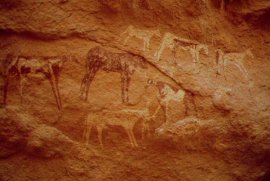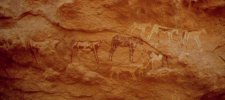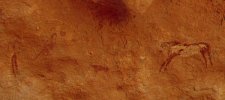


|
Mogharet el Kantara (Shaw's Cave) |
During the 1935 expedition led by W.B.K. Shaw, the much broken southern part of the Gilf Kebir plateau was explored, and two broad valleys, the Wadi Wassa and the Wadi Firaq were discovered, traversing the entire width of the plateau. (These wadis were later used as a short cut during WW II. for the convoys supplying occupied Kufra from Wadi Halfa). On the col separating the two wadis, almost on level with the top of the plateau, a member of the party, Rupert Harding Newman discovered a series of rock paintings in a small rock overhang.
The overhang forms a low shelter, and the paintings depiciting mainly cattle and a homestead scene are located about 40-50 cm above the ground, in an almost continuous line along the rear of the shelter. The discovery was published by Shaw in Antiquity, Vol.X No.38 (June 1936), pp. 175-178 "Rock Paintings in the Libyan Desert". Shaw published one photo and a few drawings. The complete site was published by Giancarlo Negro and Yves Gauthier in Sahara 9. (1997) To this day, this is the only known rock art site in the South-eastern half of the Gilf Kebir.
Left Group

Center Group

Right Group


|

|

|